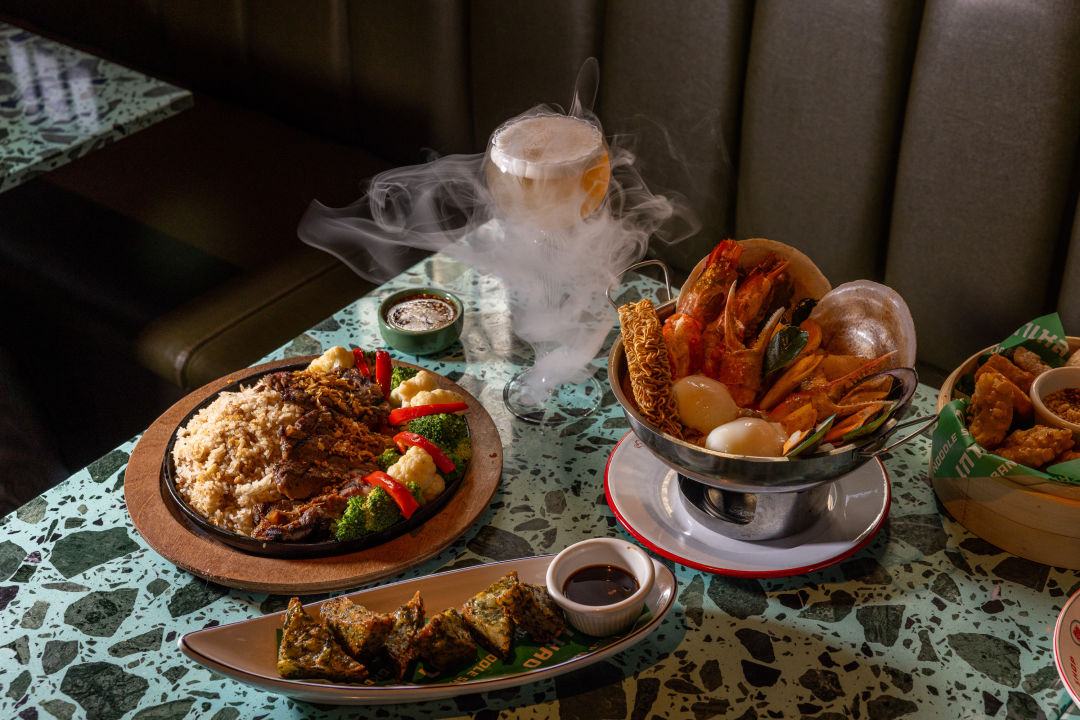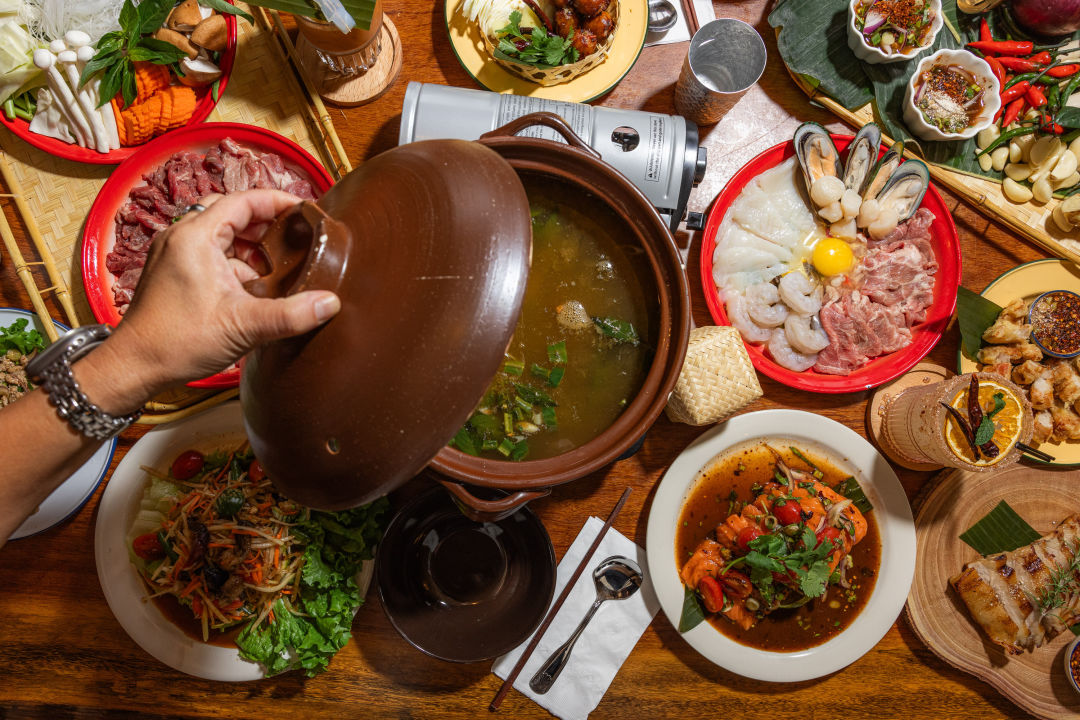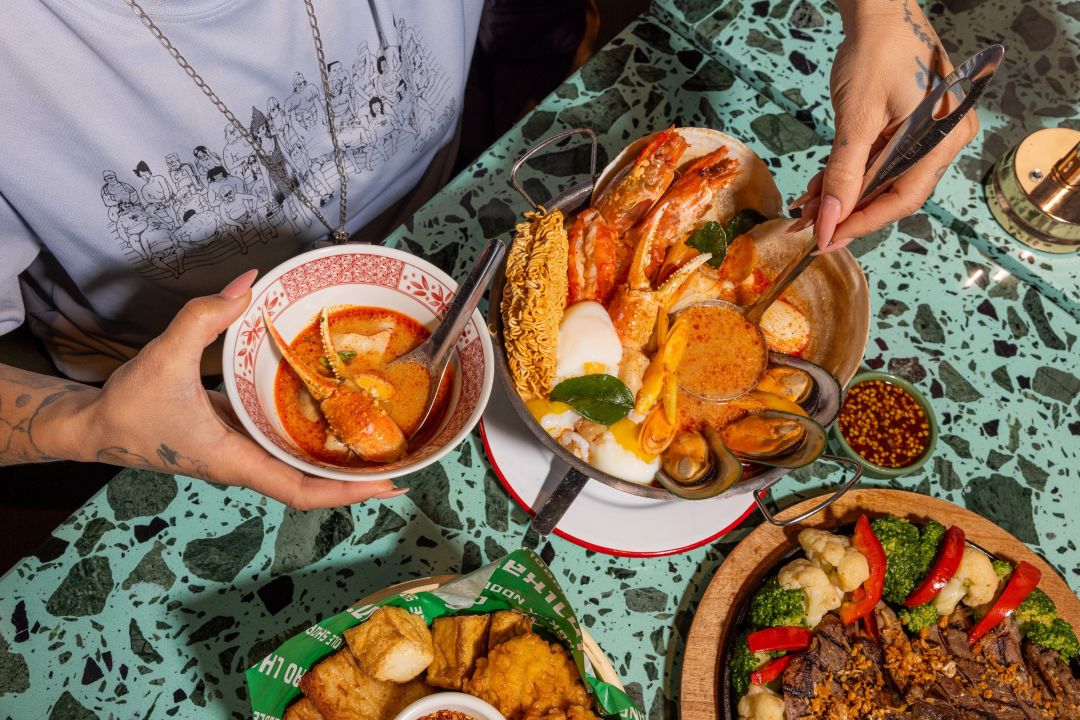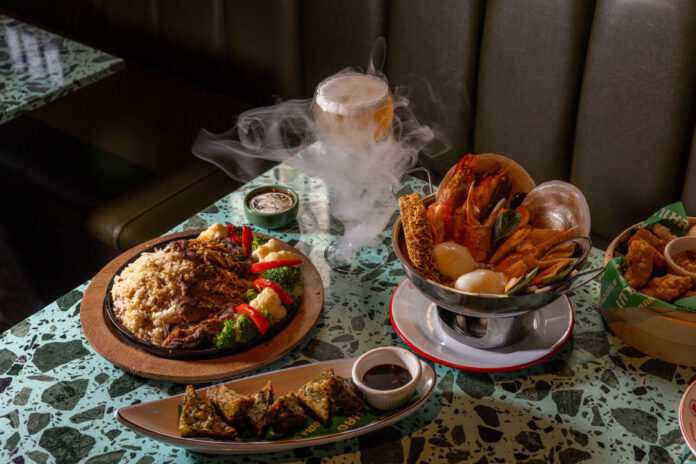This post was originally published on this site

Gao Lhao brings the excitement—and food—of Bangkok’s Chinatown to Green Lake.
Younger siblings are boisterous, gregarious, rebellious. They get loud and question authority while their older siblings stick to rules and color within the lines. When our server at Larb left a small burner, already lit, uncovered on our table while they returned to the kitchen for our hot pot, one of my daughters poked the blue flame with a spoon. Her big sister quickly chastised her. Larb is itself a little sibling—from the same folks as the U District’s Thaprachan—and suitably charismatic from an early age, ready to prod everyone around it into rethinking the tacit rules of local Thai restaurants.
Since Larb opened in July, two more younger sibling Thai restaurants have opened in Seattle: Gao Lhao from the folks behind Kin Len Thai Night Bites and Isarn Thai Soul Kitchen, and Roy Southern Thai Cuisine from the Pestle Rock and Sen Noodle Bar team. Each brings to life a specific regional Thai cuisine with niche dishes not seen on the menus at the city’s myriad Thai restaurants, and does so in true younger sibling fashion: norm-busting, vivacious, and utterly charming.

Shoreline’s Larb prioritizes making Thai food to appeal to Thai customers.
Larb Thai Street Food
Larb focuses on Isaan cuisine, as many restaurants claim to, but here, it tastes like the Northern Thai and Lao dishes served at rickety tables in Chiang Mai and in bubbling pots set out along the Mekong in Luang Prabang. In a world of sweet chili sauces boring enough to put a Muay Thai fight crowd to sleep, the one Larb serves alongside fried fish cakes lands a knockout punch, building heat with a slow burn, popping with peanuts and cucumber crunch.
“We think about Thai people, number one,” says Panarat Imig, who goes by Ying. The manager and one of the three partners behind Larb, Ying has worked in Thai restaurants in Seattle for nearly a decade. When she and Salisa Chaowanawathi (her partner in Thaprachan) teamed up with a third former coworker, Irada Phuetphakwan, they set out to do things differently at the restaurant just across the city border in Shoreline.

The wood paneled interior of Larb imitates that of traditional Thai houses.
The group chose Isaan cuisine in part because of Phuetphakwan’s cooking it, in part because of its popularity in the Thai community, and in part because of the vibe they knew it would create. The salad, for example, is spicy, Ying explains, so you have to have lots of accompaniments—dried meat, sausage, pork rinds—and that brings something else. “The laughter, the sound that it makes, that makes it more fun for us, like more alive.”
The liveliness is palpable at Larb, something Ying aimed for when they centered the menu on yak jim joom, the hot pot that arrived to cover the open flame on my table. Her idea was that the active participation of dipping and dunking would force people to put their phones down and spark more conversation. It worked, even if our conversation was mostly wondering if there was a proper order to dipping the platter of raw meat and egg and selection of vegetables into the broth and pair of sauces. Other dishes, like the mushroom larb—a culantro-scented vegetarian take on the ground meat salad—needed no such help.

Larb has hot pot on the menu in part because the interactive nature encourages people to put their phones down.
“We’re trying to be in Thailand,” Ying says, pointing to the metal cups that keep the water cool and the walls of patterned dark wood paneling as if in a traditional Thai house. Details like the ceramic jar on the wall, traditionally used for fish fermentation—but for many families, where the money was kept—offer a subtle wink at the restaurant’s primary audience.

Jennifer and Saravut Nawasangarun use what they learned from their previous restaurants to push Seattleites out of their comfort zones and into Bangkok’s Chinatown.
Gao Lhao Bangkok Noodle Shop
The decor speaks louder at Green Lake’s Gao Lhao, where neon lights and murals of street vendors telegraph the specific excitement of Bangkok’s Chinatown. Happy hour kicks off with boozy chrysanthemum or Thai tea slushies and hot plates sizzle to the table with steak and garlic butter rice. “Everything is a lot of art,” says cofounder Jennifer Nawasangarun. “The experience that you actually come into, the feelings that you feel, the music that you hear, the food that’s created.”
Jennifer and her husband, Saravut, opened their first restaurant, Isarn Thai Soul Kitchen, in Kirkland in 2014. “It was a struggle for me,” she says. “There were dishes that we wanted to introduce that the community didn’t fully understand.” While they pulled some regional dishes from Isaan cuisine, they felt forced to supplement with other dishes more familiar to customers.

Neon lights and murals bring Yaowarat Road to life inside Gao Lhao.
They opened without pad Thai on the menu, but eventually acquiesced to customer demand, theorizing that maybe from there, people would branch out. In 2020, they used what they learned to open Kin Len Thai Night Bites in Fremont, educating customers on what makes dishes special and where the flavors come from. “It was a level up for us, to be able to connect with the customer a bit more, and they were more open.” At Gao Lhao, they turn that up another notch. “Having the server actually being able to relate the dish and explain to a customer about where this is coming from and getting to know a little history of it.”
That history, specifically, comes from Saravut’s experience growing up Thai Chinese and going with his parents to Yaowarat Road, the bustling boulevard at the heart of Bangkok’s Chinatown, to shop for Chinese herbs and maybe stop for lunch at roadside stands. A painting of an elderly man smiling as he stirs a pot dominates the back wall, a lit sign above advertises the soup; tiffins, teapots, and glass jars of dried ingredients decorate the bar.
The colors and textures, the khaki vests the servers wear emblazoned with the restaurant’s name, the music; it all feels exciting, as if I’m joining a stroll down the busy street. But it’s the food that cements it. Like Larb, the food sidesteps the familiar classics of Seattle Thai food. It’s more along the lines of what Saruvat might have eaten at one of those roadside stands back in Bangkok. My best advice: Order like a drunk person wandering the street late at night, following your nose and the green neon lights. The biggest hits come from venturing out of the familiar and choosing the smoky pandan leaf-wrapped chicken, dipped in sweet soy sauce instead of the more typical fish sauce wings to start. The almond yuzu salad seemed as if ambrosia salad spent a month backpacking through Southeast Asia. The crisp garlicky wild cod looked like adult fishy nuggets but tasted like fine dining. The Chinese black olive green beans were the most surprising hit from my meals there; the less I could imagine what the dish might taste like, the better it turned out.
“In Thailand, there’s so much culture, it’s not just the Thai culture itself,” Jennifer explains. Northern, Southern, Chinese, and all kinds of combinations. “It’s growing, and it’s changing and shifting… It gets more interesting.” The same can be said of Seattle’s expanding, exciting Thai food scene.
Roy Southern Thai Cuisine
When the Jawpliphon siblings’ Pestle Rock opened in 2012, it was among the early restaurants pushing Seattle out of the pad Thai cave, using big bowls of khao soi noodles in creamy coconut broth and the crunchy rice of yum khao tod. Now, at Phinney Ridge’s Roy, they explore in the opposite direction from their hometown of Bangkok, sliding down the country’s south as it extends along the Malay peninsula, drawing influence from Malaysia, Singapore, and even the subcontinent across the water.
The bar at the center of the room still reflects the space’s long run as a neighborhood pub, but now it’s tiled in turquoise, and backlit, though the many televisions behind it remain tuned to sports. A flag of Thailand is joined by a rainbow pride flag, and fresh greenery hangs in pots from the ceiling. The sunny feel of the citrus-bright walls matches the color of turmeric-flecked wild rockfish curry into which my impulsive youngest discovered the delights of dipping layered roti. The same dish introduces me to the green leaf called chaplu.
Seattle still lacks a Bangladeshi restaurant, but Roy serves its own version of beef bhuna, the country’s thick, rich curry. The herbal broth on the bak kut teh, a pork bone soup, has Hokkien roots. The stuffed mataba flatbread is a traditional Thai Muslim street dish. With each item, the restaurant extends Seattle’s notions of Thai food and introduces another facet of the country’s cuisine.
“A lot of Thai restaurants have been afraid to come out of that safe zone,” Jennifer says, making them hesitant to put new dishes on the menu. “But once they see that one person does it and it works, then they start doing it.” The winners, when they do, are Seattle diners.
















